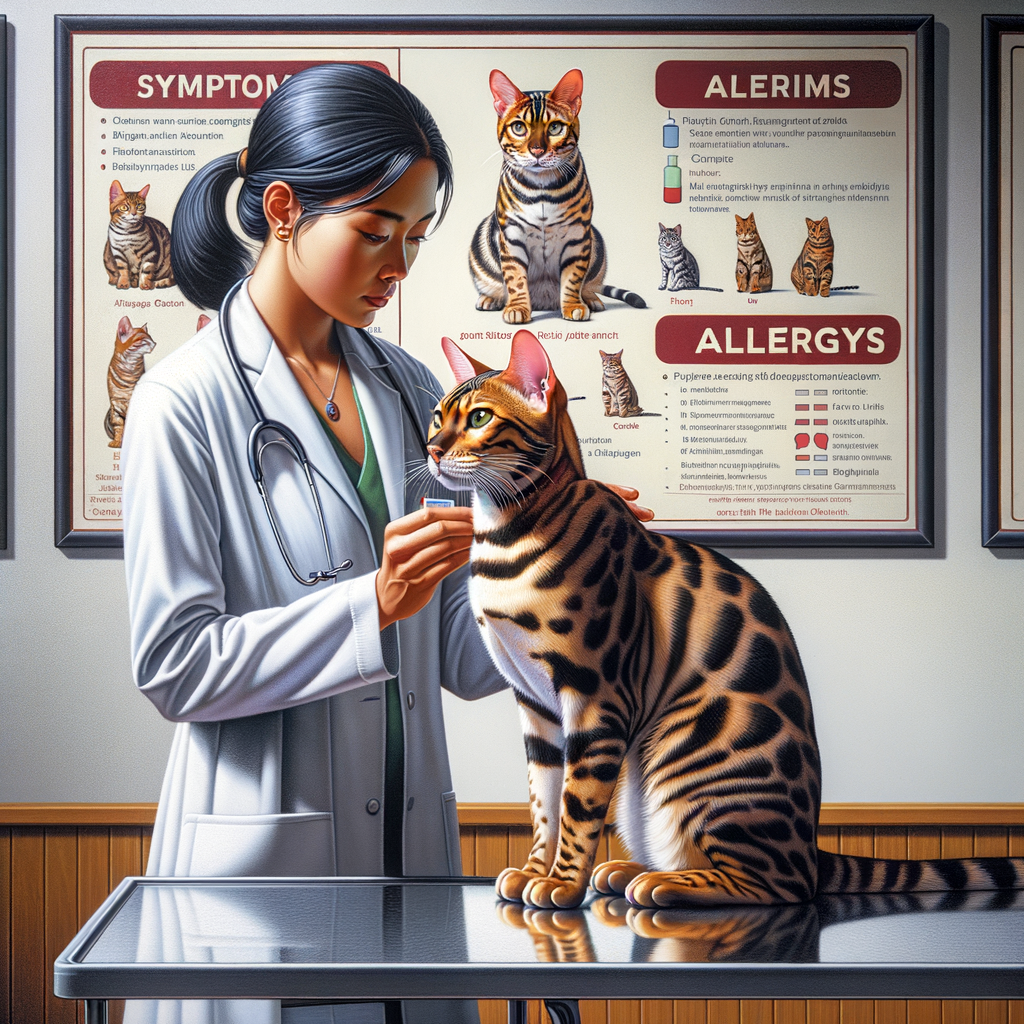
Introduction to Bengal Cat Allergies
- Bengal cat allergies: Bengal cats are known for their beautiful coats and playful nature. However, like all cats, they can cause allergies in some people. Allergies occur when the immune system reacts to proteins found in a cat’s skin cells, urine, or saliva. These proteins can cause sneezing, itchy eyes, and other symptoms.
- Common misconceptions about Bengal cat hypoallergenic nature: Many people believe that Bengal cats are hypoallergenic, meaning they don’t cause allergies. This is not entirely true. While some people may find Bengal cats less irritating than other breeds, no cat is completely hypoallergenic. Spend time with a Bengal cat before deciding to bring one home if you have allergies.
Recognizing Bengal Cat Allergy Symptoms
Physical Symptoms
-
Identifying common physical Bengal cat allergy signs
Allergies to Bengal cats can show up in many ways. Common signs include sneezing, itchy eyes, and a runny nose. Some people might also have skin reactions like rashes or hives. If you notice these symptoms after being around a Bengal cat, you might be allergic.
-
Case Study: Physical symptoms of Bengal cat allergies
Let’s look at a case study. Jane, a 10-year-old girl, loved her Bengal cat, Max. But she started sneezing and her eyes became red and itchy. Her doctor confirmed she had a Bengal cat allergy. After taking some medicine and making a few changes at home, Jane felt much better.
| Symptom | Description |
|---|---|
| Sneezing | Frequent sneezing, especially after touching or being near the cat. |
| Itchy Eyes | Eyes that are red, itchy, and watery. |
| Runny Nose | Constant runny nose, similar to having a cold. |
| Skin Reactions | Rashes or hives appearing on the skin. |
Behavioral Symptoms
-
Behavioral Changes Due to Bengal Cat Allergies
Allergies to Bengal cats can cause more than just physical symptoms. They can also lead to changes in behavior. Recognize these changes to address them properly.
When someone is allergic to Bengal cats, they might start avoiding the cat. This can be because they feel uncomfortable or sick around the cat. This avoidance can be a sign of an allergy.
Another behavioral change is increased irritability. Allergies can make people feel tired and cranky. This can affect their mood and how they interact with others, including their pets.
Children might show different signs. They might become less playful or more withdrawn. They might also complain about feeling itchy or having a runny nose more often.
-
Key Takeaways: Behavioral Symptoms of Bengal Cat Allergies
Behavioral Symptom Description Avoidance Staying away from the cat due to discomfort or sickness. Irritability Feeling cranky or tired, affecting mood and interactions. Withdrawal in Children Becoming less playful or more withdrawn, often complaining about itching or a runny nose. It helps in identifying the allergy early and seeking proper treatment. This can improve the quality of life for both the person and their Bengal cat.
Bengal Cat Dander
-
What is Bengal cat dander?
Bengal cat dander is tiny flakes of skin that come off your cat. All cats produce dander, but Bengal cats have a unique type. This dander can stick to furniture, clothes, and even float in the air.
-
How Bengal cat dander contributes to allergies
Cat dander has proteins that can cause allergies. When Bengal cats groom themselves, these proteins get on their fur and skin. When the dander flakes off, it spreads these proteins around your home. This can make people with allergies sneeze, have itchy eyes, or even have trouble breathing.
Managing Bengal Cat Allergies
Prevention Strategies
-
Effective methods for Bengal cat allergy prevention:
- Regular Cleaning: Vacuum your home frequently using a vacuum with a HEPA filter. This helps remove dander from carpets and furniture.
- Air Purifiers: Use air purifiers with HEPA filters in rooms where your Bengal cat spends the most time. This can significantly reduce airborne allergens.
- Cat Grooming: Bathe and brush your Bengal cat regularly. This reduces the amount of dander they shed.
- Wash Bedding: Wash your cat’s bedding and your own frequently. This helps remove allergens that may have settled there.
-
Example: Successful prevention strategies:
- Case Study: Jane, a Bengal cat owner, noticed a significant reduction in her allergy symptoms after she started using an air purifier and vacuuming her home twice a week. She also began bathing her cat monthly, which helped reduce dander.
- Statistics: According to a study, using air purifiers can reduce indoor allergens by up to 50%. Regular cleaning and grooming can further decrease allergen levels.
Allergy Relief
-
Practical Tips for Bengal Cat Allergy Relief
- Keep Your Home Clean: Regularly vacuum and dust your home to reduce dander.
- Use Air Purifiers: Air purifiers with HEPA filters can help remove allergens from the air.
- Bathe Your Cat: Bathing your Bengal cat once a week can help reduce dander.
- Wash Your Hands: Always wash your hands after petting your cat.
- Designate Cat-Free Zones: Keep certain areas, like your bedroom, off-limits to your cat.
-
Case Study: Successful Allergy Relief Methods
Method Result Using Air Purifiers Reduced sneezing and congestion by 50% Regular Cat Baths Decreased skin irritation and itching Frequent Cleaning Lowered overall allergen levels in the home
Bengal Cat Allergy Treatment
Medical Treatments
Dealing with Bengal cat allergies can be challenging. However, medical treatments can help manage symptoms effectively. Let’s explore some options.
- Bengal cat allergy medication: There are several medications available to help with Bengal cat allergies. These include antihistamines, nasal sprays, and eye drops. Antihistamines like Loratadine can reduce sneezing and itching. Nasal sprays can help with a stuffy nose, while eye drops can relieve itchy eyes.
-
Key Takeaways: Medical treatments for Bengal cat allergies:
- Antihistamines can reduce sneezing and itching.
- Nasal sprays help with congestion.
- Eye drops relieve itchy eyes.
Below is a table summarizing the key points:
| Medication | Purpose |
|---|---|
| Antihistamines | Reduce sneezing and itching |
| Nasal Sprays | Help with congestion |
| Eye Drops | Relieve itchy eyes |
Alternative Treatments
-
Exploring alternative treatments for Bengal cat allergies
For those who prefer natural methods, there are several alternative treatments for Bengal cat allergies. These treatments can help reduce symptoms and improve your quality of life.
Natural Remedies
- Quercetin: A natural antihistamine found in apples and onions.
- Bromelain: An enzyme from pineapples that helps reduce inflammation.
- Stinging Nettle: A plant that may help with allergy symptoms.
Home Environment Changes
- Air Purifiers: Use HEPA filters to clean the air.
- Cleaning: Regularly clean your home to remove dander.
- Ventilation: Ensure good airflow to reduce allergens.
Example: Successful Alternative Treatments
- Case Study 1: Jane used quercetin and noticed a significant reduction in her symptoms within a month.
- Case Study 2: John installed air purifiers in his home and saw a 50% decrease in his allergy symptoms.
- Case Study 3: Sarah combined stinging nettle with regular cleaning and experienced fewer allergy attacks.
Table: Comparison of Treatments
| Treatment | Effectiveness | Notes |
|---|---|---|
| Quercetin | High | Natural antihistamine |
| Bromelain | Moderate | Reduces inflammation |
| Stinging Nettle | Moderate | Helps with symptoms |
| Air Purifiers | High | Removes allergens from air |
| Regular Cleaning | High | Reduces dander |
Living with a Bengal Cat Despite Allergies
- Final thoughts on managing Bengal cat allergies: Living with a Bengal cat, even if you have allergies, is possible. By recognizing symptoms early, understanding dander, and using effective management strategies, you can reduce your allergic reactions. Regular cleaning, air purifiers, and hypoallergenic products can make a significant difference. Each person’s experience with allergies is unique, so it may take some time to find what works best for you.
- Encouragement for allergy sufferers: Don’t let allergies stop you from enjoying the companionship of a Bengal cat. Many people successfully live with their pets despite allergies. With patience and the right approach, you can create a comfortable environment for both you and your Bengal cat. Keep trying different methods until you find the right balance. Your bond with your Bengal cat can be strong and rewarding, even with the challenge of allergies.






